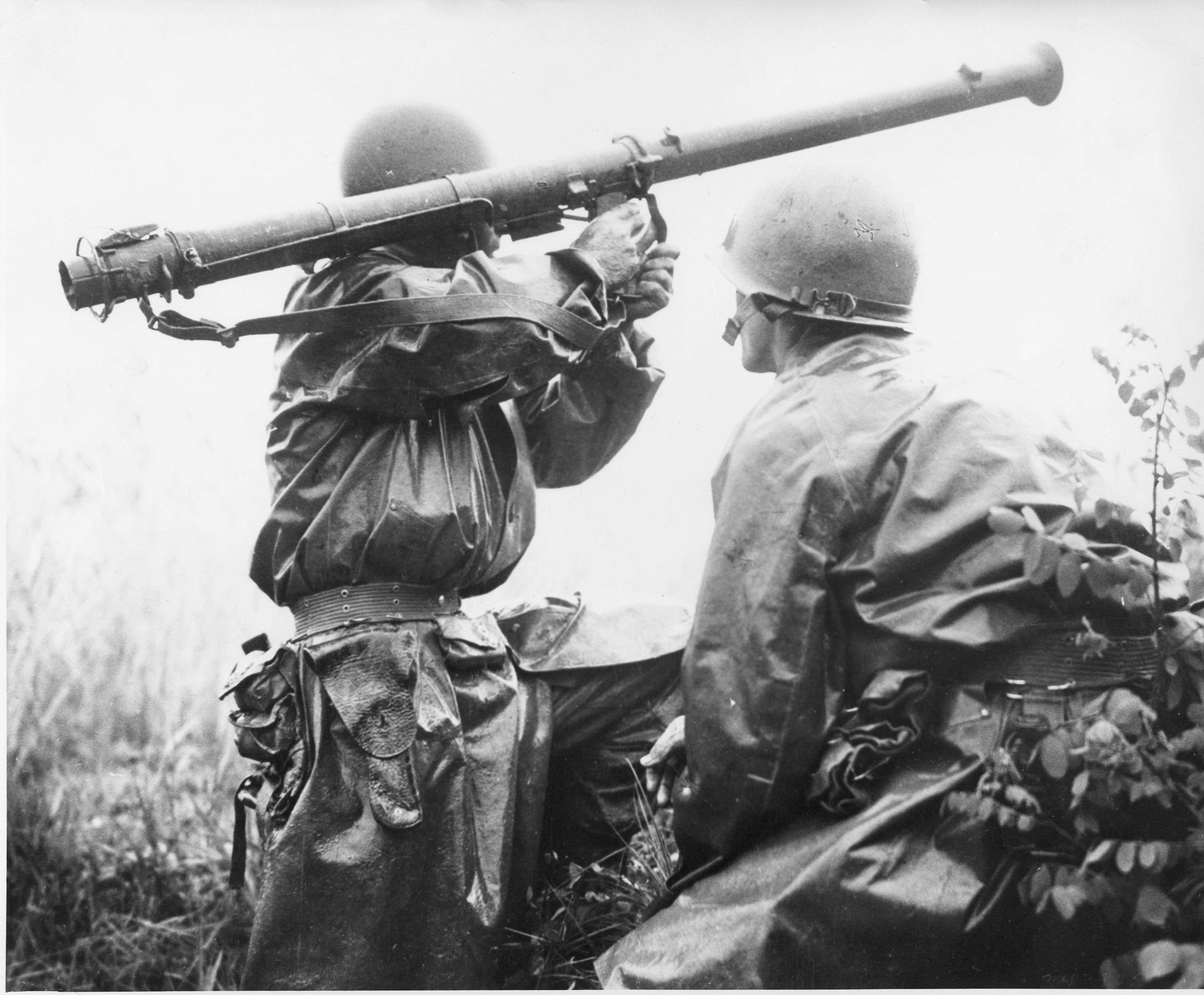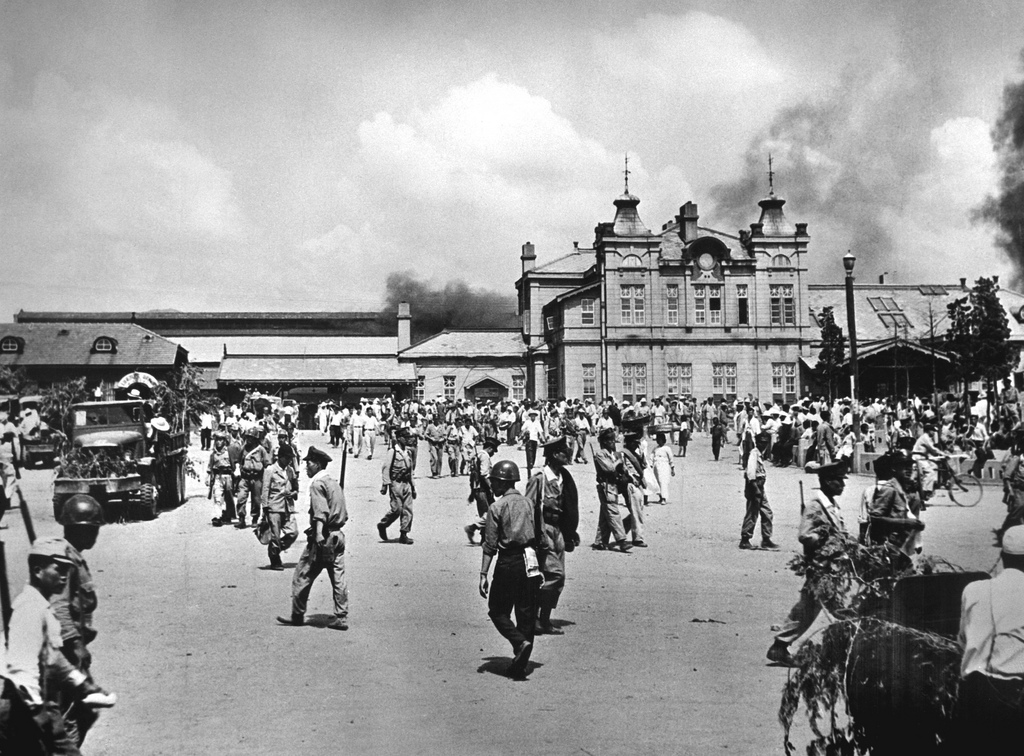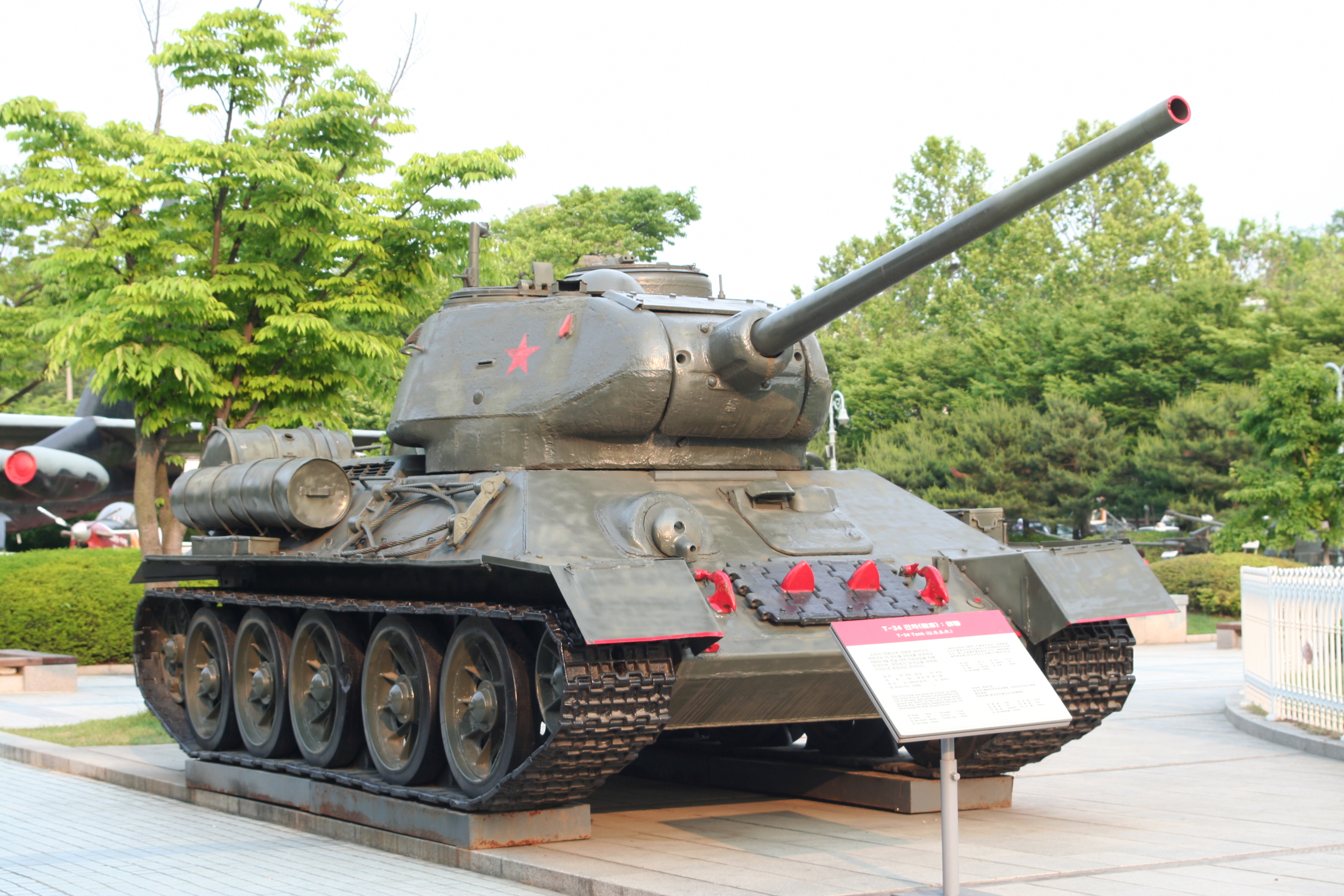|
Battle Of The Bowling Alley
In the Battle of the Bowling Alley (August 21, 1950), United Nations Command (UN) forces defeated North Korean forces early in the Korean War near the city of Taegu, South Korea. The battle took place in a narrow valley, dubbed the "Bowling Alley", which was north of Taegu. It followed a week of fighting between the Korean People's Army (KPA) 13th Division and the Republic of Korea Army's (ROK) 1st Division along the latter's last defensible line in the hills north of the city. Reinforcements, including the US Army's 27th and 23rd Infantry Regiments were committed to bolster the ROK defenses. This battle and several others were smaller engagements of the Battle of Pusan Perimeter. For another week, KPA divisions launched all the troops they had in massed attacks against the ROK and US lines. Their attacks, which usually occurred at night and were supported by armor and artillery, advanced with infantry and tanks in close support of one another. Each KPA attack ran into well- ... [...More Info...] [...Related Items...] OR: [Wikipedia] [Google] [Baidu] |
Tank Action In The Bowling Alley
A tank is an armoured fighting vehicle intended as a primary offensive weapon in front-line ground combat. Tank designs are a balance of heavy firepower, strong armour, and good battlefield mobility provided by tracks and a powerful engine; usually their main armament is mounted in a turret. They are a mainstay of modern 20th and 21st century ground forces and a key part of combined arms combat. Modern tanks are versatile mobile land weapons platforms whose main armament is a large- caliber tank gun mounted in a rotating gun turret, supplemented by machine guns or other ranged weapons such as anti-tank guided missiles or rocket launchers. They have heavy vehicle armour which provides protection for the crew, the vehicle's munition storage, fuel tank and propulsion systems. The use of tracks rather than wheels provides improved operational mobility which allows the tank to overcome rugged terrain and adverse conditions such as mud and ice/snow better than wheeled vehicles ... [...More Info...] [...Related Items...] OR: [Wikipedia] [Google] [Baidu] |
Task Force Smith
The Battle of Osan ( ko, 오산 전투) was the first engagement between the United States and North Korea during the Korean War. On July 5, 1950, Task Force Smith, an American task force of 540 infantry supported by an artillery battery, was moved to Osan, south of Seoul, the capital of South Korea, and was ordered to fight as a rearguard to delay the advancing North Korean forces while more US troops arrived to form a stronger defensive line to the south. The task force lacked both anti-tank guns and effective infantry anti-tank weapons and had been equipped with obsolete 2.36-inch (60 mm) rocket launchers and a few 57 mm recoilless rifles. Aside from a limited number of HEAT shells for the unit's 105 mm howitzers, crew-served weapons that could defeat T-34/85 tanks from the Soviet Union had not yet been distributed to the US Army forces in Korea. A North Korean tank column equipped with ex-Soviet T-34/85 tanks overran the task force in the first encounter and continued ... [...More Info...] [...Related Items...] OR: [Wikipedia] [Google] [Baidu] |
Battle Of Taejon
The Battle of Taejon (14–21 July 1950) was an early battle of the Korean War, between U.S. and North Korean forces. Forces of the United States Army attempted to defend the headquarters of the 24th Infantry Division. The 24th Infantry Division was overwhelmed by numerically superior forces of the Korean People's Army (KPA) at the major city and transportation hub of Taejon. The 24th Infantry Division's regiments were already exhausted from the previous two weeks of delaying actions to stem the advance of the KPA. The entire 24th Division gathered to make a final stand around Taejon, holding a line along the Kum River to the east of the city. Hampered by a lack of communication and equipment, and a shortage of heavy weapons to match the KPA's firepower, the outnumbered, ill-equipped and untrained U.S. forces were pushed back from the riverbank after several days before fighting an intense urban battle to defend the city. After a fierce three-day struggle, the U.S. withdrew. Al ... [...More Info...] [...Related Items...] OR: [Wikipedia] [Google] [Baidu] |
Battle Of Pyongtaek
The Battle of Pyongtaek was the second engagement between United States and North Korean forces during the Korean War, occurring on July 6, 1950 in the village of Pyongtaek in western South Korea. The fight ended in a North Korean victory following unsuccessful attempts by American forces to inflict significant damage or delays on advancing North Korean units, despite several opportunities to do so. The United States Army's 34th Infantry Regiment, 24th Infantry Division was assigned to delay elements of the North Korean People's Army's 4th Infantry Division as it advanced south following its victory at the Battle of Osan the day before. The regiment emplaced at Pyongtaek and Ansong attempting to form a line to hold the North Koreans in an area where the terrain formed a bottleneck between mountains and the Yellow Sea. Half of the regiment's strength was ordered to retreat from its position before the North Korean force was encountered, leaving the flank open for the remaining ... [...More Info...] [...Related Items...] OR: [Wikipedia] [Google] [Baidu] |
Battle Of Chonan
The Battle of Chonan was the third engagement between United States and North Korean forces during the Korean War. It occurred on the night of July 7/8, 1950 in the village of Chonan in western South Korea. The fight ended in a North Korean victory after intense fighting around the town, which took place throughout the night and into the morning. The United States Army's 34th Infantry Regiment, 24th Infantry Division was assigned to delay elements of the North Korean People's Army's 4th Infantry Division as it advanced south following its victories at the Battle of Osan and the Battle of Pyongtaek the days before. The regiment emplaced north and south of Chonan attempting to delay the North Koreans in an area where the terrain formed a bottleneck between mountains and the Yellow Sea. The 3rd Battalion, 34th Infantry set up a defensive perimeter north of the city, and by nightfall was engaged in combat with superior numbers of North Korean troops and tanks. American forces, un ... [...More Info...] [...Related Items...] OR: [Wikipedia] [Google] [Baidu] |
Battle Of Chochiwon
The Battle of Chochiwon was an early engagement between United States and North Korean forces during the Korean War, taking place in the villages of Chonui and Chochiwon in western South Korea on July 10–12, 1950. After three days of intense fighting, the battle ended in a North Korean victory. The United States Army's 21st Infantry Regiment, 24th Infantry Division was assigned to delay two advancing North Korean People's Army divisions following communist victories at Osan, Pyongtaek, and Chonan earlier in the month. The regiment deployed along roads and railroads in between the two villages, attempting to slow the advance as much as possible. Aided by air strikes, U.S. Army units were able to inflict substantial damage on the North Korean armor and other vehicles, but were overwhelmed by North Korean infantry. The two understrength U.S. battalions fought in several engagements over the three-day period and suffered massive losses in personnel and equipment, but were able ... [...More Info...] [...Related Items...] OR: [Wikipedia] [Google] [Baidu] |
Battle Of Osan
The Battle of Osan ( ko, 오산 전투) was the first engagement between the United States and North Korea during the Korean War. On July 5, 1950, Task Force Smith, an American task force of 540 infantry supported by an artillery battery, was moved to Osan, south of Seoul, the capital of South Korea, and was ordered to fight as a rearguard to delay the advancing North Korean forces while more US troops arrived to form a stronger defensive line to the south. The task force lacked both anti-tank guns and effective infantry anti-tank weapons and had been equipped with obsolete 2.36-inch (60 mm) rocket launchers and a few 57 mm recoilless rifles. Aside from a limited number of HEAT shells for the unit's 105 mm howitzers, crew-served weapons that could defeat T-34/85 tanks from the Soviet Union had not yet been distributed to the US Army forces in Korea. A North Korean tank column equipped with ex-Soviet T-34/85 tanks overran the task force in the first encounter and continued ... [...More Info...] [...Related Items...] OR: [Wikipedia] [Google] [Baidu] |
Eighth United States Army
The Eighth Army is a U.S. field army which is the commanding formation of all United States Army United States Forces Korea, forces in South Korea. It commands U.S. and South Korean units and is headquartered at the Camp Humphreys,Yongsan garrison move pushed back to 2019 in the Anjeong-ri of Pyeongtaek, Pyeongtaek, South Korea. It is the only field army in the U.S. Army. History World War II The unit first activated on 10 June 1944 in the United States, under the command of Lieutenant General Robert Eichelberger. The Eighth Army took part in many of the amphibious landings in the Southwest Pacific Theater of World War II, eventually participating in no less than sixty of them. The first mission of the Eighth Army, in September 1944, was to ta ...[...More Info...] [...Related Items...] OR: [Wikipedia] [Google] [Baidu] |
25th Infantry Division (United States)
The 25th Infantry Division (nicknamed "Tropic Lightning") is a United States Army division based at Schofield Barracks in Hawaii. The division, which was activated on 1 October 1941 in Hawaii, conducts military operations primarily in the Asia-Pacific region. Its present deployment is composed of light infantry and aviation units. Tropic Lightning soldiers regularly train with other U.S. military branches to practice and maintain joint operations capabilities. The climate and terrain of the Pacific region demands Tropic Lightning soldiers be able to operate in physically demanding and harsh environments. In 2014, the division opened the Jungle Operations Training Center—the first such school in the Army since the closing of the old Jungle Warfare School at Fort Sherman, Panama Canal Zone. Joint operations and training with partner states herald a new chapter in the history of Tropic Lightning—America's Pacific Division. The division was originally activated from Hawaii garr ... [...More Info...] [...Related Items...] OR: [Wikipedia] [Google] [Baidu] |
7th Infantry Division (United States)
The 7th Infantry Division is an active duty infantry division of the United States Army based at Joint Base Lewis-McChord charged with sustaining the combat readiness of two Stryker brigade combat teams, a combat aviation brigade, a division artillery headquarters, and a National Guard Stryker brigade combat team, as well as participating in several yearly partnered exercises and operations in support of U.S. Army Pacific and the Indo-Pacific region. The 7th Infantry Division is the only active-duty multi-component division headquarters in the Army. The 7th Infantry Division is also home to two of the Army's newest enabling battlefield capabilities, the Multi Domain Task Force and the Intelligence, Information, Cyber, Electronic Warfare and Space Capabilities, or I2CEWS battalion. The division was first activated in December 1917 in World War I, and has been based at Fort Ord, California for most of its history. Although elements of the division saw brief active service in Wo ... [...More Info...] [...Related Items...] OR: [Wikipedia] [Google] [Baidu] |
1st Cavalry Division (United States)
The 1st Cavalry Division ("First Team") is a Armored brigade combat team, combined arms division (military), division and is one of the most decorated combat divisions of the United States Army. It is based at Fort Hood, Texas. It was formed in 1921 and served during World War II, the Korean War, the Vietnam War, the Persian Gulf War, with the Stabilization Force in Bosnia-Herzegovina, in the Iraq War, in the War in Afghanistan (2001–present), War in Afghanistan and in Operation Freedom's Sentinel. As of October 2017, the 1st Cavalry Division is subordinate to III Armored Corps and is commanded by Major General John B. Richardson. The unit is unique in that it has served as a Cavalry, horseback cavalry division until 1943, an infantry division, an air assault division and an armored division during its existence. History The history of the 1st Cavalry Division began in 1921 after the army established a permanent cavalry division Table of Organization and Equipment, table o ... [...More Info...] [...Related Items...] OR: [Wikipedia] [Google] [Baidu] |
24th Infantry Division (United States)
The 24th Infantry Division was an infantry division of the United States Army that was inactivated in October 1996. Formed during World War II from the disbanding Hawaiian Division, the division saw action throughout the Pacific theater, first fighting in New Guinea before landing on the Philippine islands of Leyte and Luzon, driving Japanese forces from them. Following the end of the war, the division participated in occupation duties in Japan, and was the first division to respond at the outbreak of the Korean War. For the first 18 months of the war, the division was heavily engaged on the front lines with North Korean and Chinese forces, suffering over 10,000 casualties. It was withdrawn from the front lines to the reserve force for the remainder of the war after the second battle for Wonju, but returned to Korea for patrol duty at the end of major combat operations. After its deployment in the Korean War, the division was active in Europe and the United States during the ... [...More Info...] [...Related Items...] OR: [Wikipedia] [Google] [Baidu] |







